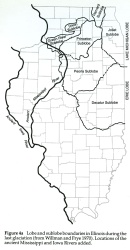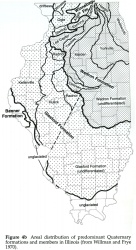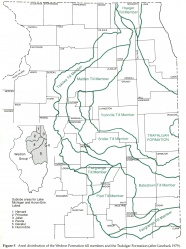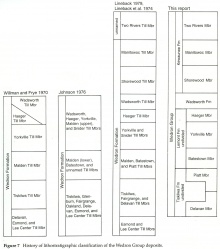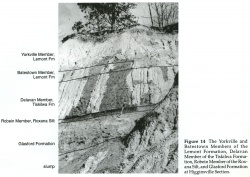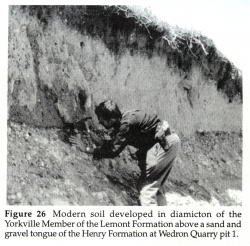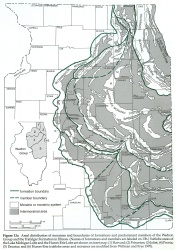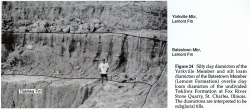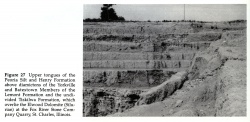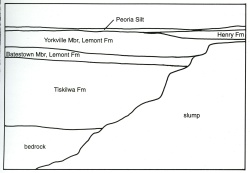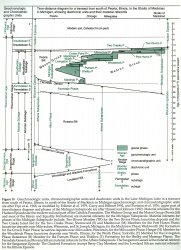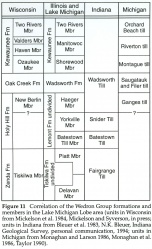Yorkville Member
Lithostratigraphy: Wedron Group >>Lemont Formation >>Yorkville Member
Chronostratigraphy: Cenozoic Erathem >>Quaternary System >>Pleistocene Series
Primary source
Hansel, Ardith K., and W. Hilton Johnson, 1996, Wedron and Mason Groups: Lithostratigraphic Reclassification of Deposits of the Wisconsin Episode, Lake Michigan Lobe Area: Illinois State Geological Survey Bulletin 104, 116 p.
Contributing author(s)
Ardith K. Hansel and W. Hilton Johnson
Name
Original description
Yorkville Till Member (Willman and Frye 1970).
Derivation
Yorkville, a village in Kendall County.
Other names
History/background
The Yorkville Till Member of the Wedron Formation was originally defined by Willman and Frye (1970). It was described as a very clayey gray till that commonly exhibits a green cast, and as being slightly darker than other gray tills. Willman and Frye (1970) mapped the Yorkville Till Member in parts of the Harvard (Barlina Moraine), Princeton (St. Charles Moraine), and Peoria (Marseilles, Minooka, and Rockdale Moraines) Sublobe areas (fig. 4). In the Decatur Sublobe area, gray silty clay to silty clay loam diamicton similar to but sandier than type-Yorkville diamicton was defined as the Snider Till Member (Johnson et al. 1971b). McKay (1975) correlated diamicton of the Snider Till Member with diamicton in the El Paso, Minonk, and Strawn Moraines in the Peoria Sublobe area that Willman and Frye (1970) had included in the Malden Till Member. Johnson (1976) included the Snider and Yorkville Till Members in a group of upper, fine textured tills of the Wedron Formation (fig. 7). On the 1979 state Quaternary map (fig. 5), Lineback extended the Snider Till Member into part of the Peoria Sublobe area where Willman and Frye (1970) originally had mapped the Malden Till Member. Later, on the basis of field relationships and statistical treatment of textural and compositional data, Moore (1981) (1) correlated diamicton in the Chatsworth, Ellis, and Paxton Moraines with the Snider Till Member in its type area; (2) reported the Yorkville and Snider were portions of a single lithologic unit; and (3) recommended on the basis of priority that the name Snider be dropped and the name Yorkville be retained for this unit. Killey (1982) identified two distinct clay-mineral zones (the Dwight averaging 76% illite and the lower Yorkville averaging 81% illite) in the area mapped as the Yorkville Till Member in Livingston, Woodford, and Marshall Counties. She attributed the zones to represent separate ice-margin advances. In this report, the Yorkville Till Member of the Wedron Formation is reclassified as the Yorkville Member of the Lemont Formation (fig. 7). The Yorkville Member description is broadened to include fine textured diamicton units (silty clay and silty clay loam) that were (1) left undivided in the Wedron Formation in the Decatur Sublobe area by Willman and Frye (1970) and subsequently classified as the Snider Till Member by Johnson et al. (1971b); (2) mapped as part of the Malden Till Member in the Princeton Sublobe area by Willman and Frye (1970); and (3) mapped as part of the Malden Till Member (Willman and Frye 1970) or a combination of the Malden and Snider Till Members in the Peoria Sublobe area (Lineback 1979).
Type section
Type location
Roadcut at the intersection of Illinois Highways 71 and 47.
Type author(s)
Type status
No longer exposed.
Reference section
Reference location
Higginsville Section (fig. 14); good for lower boundary and lithology. Wedron Section; good for lower boundary (fig. 26). Core 7815; good for lithology.
Reference author(s)
Reference status
Stratigraphic relationships
The Yorkville Member is the fine grained, middle unit of diamicton in the Lemont Formation. It is generally dark gray, silty clay to silty clay loam diamicton that oxidizes to olive brown.
The Yorkville Member diamicton generally contains more clay than the underlying Batestown Member diamicton. However, where the Batestown Member diamicton is finer textured than type-Batestown diamicton, differentiation between the two units is more difficult, and locally a vertical boundary is needed to distinguish them for mapping purposes. For example, in the Peoria Sublobe area, a vertical boundary is used at the front of the El Paso Moraine to separate the silty clay diamicton of the Yorkville Member from diamicton beyond the moraine that has a similar texture, but which we consider to be a fine grained facies of the Batestown Member (fig. 13). In vertical sequence, sorted sediment of the Equality and Henry Formations is often present between diamicton units of the Batestown and Yorkville Members and helps to differentiate the two units. Diamicton of the Yorkville Member is much finer than the coarse textured diamicton of the Haeger Member in the area of the Harvard Sublobe. Stratified sand and gravel of the Beverly Tongue of the Henry Formation is common beneath diamicton of the Haeger Member and correlative diamicton of the undivided Lemont Formation. The upper boundary of the Yorkville Member is more problematic in the Joliet Sublobe area where fine textured diamicton of the Wadsworth Formation may be in contact with that of the Yorkville Member. In that area, a vertical boundary at the West Chicago-Wilton Center moraine front is used to demarcate the unit boundary (fig. 13). The latter ice-margin position coincides approximately with the erosional margin of Silurian bedrock, where the Yorkville Member pinches out or is in facies relationship with the basal part of the undivided Lemont Formation. Locally, diamicton of the Yorkville Member may be red gray or red brown; the uncharacteristic redder hues and lithology have been interpreted to reflect incorporation of diamicton of the Tiskilwa Formation (Wickham et al. 1988).
|
Extent and thickness
The Yorkville Member forms a wedge-shaped diamicton unit that overlaps the Batestown Member, the Tiskilwa Formation, older units, or bedrock. Although the Yorkville Member crops out over a large area, it pinches out for a very short distance north and east beneath the Haeger Member in the Harvard Sublobe area and the undivided Lemont Formation or the Wadsworth Formation in the Joliet Sublobe area (fig. 13). The Yorkville Member is up to 60 meters (197 ft) thick in some parts of the Marseilles Morainic System (Willman and Payne 1942).
Lithology
The Yorkville Member of the Lemont Formation consists of calcareous, gray, fine textured (silty clay to silty clay loam) diamicton that contains lenses of gravel, sand, silt, and clay. Typically, it oxidizes to olive brown. Paleozoic shale and dolomite are common clast lithologies. As noted by Willman and Frye (1970), the weathered surface of Yorkville diamicton commonly contains a concentration of small dolomitic pebbles, giving it the appearance of gravel.
Core(s)
Photograph(s)
Contacts
Lower Boundary: the contact with the Batestown Member (figs. 14, 24), the Tiskilwa Formation, tongues of the Henry (fig. 26) and Equality Formations, older units, or bedrock. Upper boundary: the contact with the Beverly Tongue of the Henry Formation, the Haeger Member, the undivided Lemont Formation, the Trafalgar Formation, the Wadsworth Formation, tongues of the Equality Formation, upper tongues of the Peoria Silt and Henry Formation (fig. 27), or postglacial units.
Well log characteristics
Fossils
Age and correlation
The Yorkville Member was deposited during the Livingston Phase of the Michigan Subepisode, probably between about 17,700 and 16,200 radiocarbon years ago (Hansel and Johnson 1992) (fig. 10). It correlates with fine textured diamicton included in the Snider Till south of the Kankakee River Valley in Indiana (fig. 11).
|
Environments of deposition
The Yorkville Member is interpreted to represent the subglacial and ice-marginal facies of multiple offlapping glacigenic sequences; it consists predominantly of till, but may also contain subaqueous debris flow and lacustrine sediment. One or more proglacial lakes likely existed between the moraines to the west and the Lake Michigan Lobe glacier, which may have wasted back to a position near the Silurian-Ordovician boundary before readvancing. The fine textured lithology of the Yorkville Member is consistent with a lacustrine and shale source.
Economic importance
Remarks
Reclassified and redescribed unit. Name changed to the Yorkville Member and unit classified as part of the Lemont Formation. Lower boundary extended in the Decatur and Peoria Sublobe areas to include fine grained diamicton units mapped by Lineback (1979) as the Snider and Malden Till Members. Formerly classified as the Yorkville Till Member of the Wedron Formation (Willman and Frye 1970).
References
HANSEL, A. K., and W. H. JOHNSON, 1992, Fluctuations of the Lake Michigan Lobe during the late Wisconsin Subepisode: Sveriges Geologiska Undersoekning, Series Ca 81, p. 133-144.
JOHNSON, W. H., 1976, Quaternary stratigraphy in Illinois—Status and current problems, in W. C. Mahaney, editor, Quaternary Stratigraphy of North America: Dowden, Hutchinson, & Ross, Inc., Stroudsburg, PA, p. 169- 196.
JOHNSON, W. H., D. L. GROSS, and S. R. MORAN, 1971b, Till stratigraphy of the Danville region, east-central Illinois, in R. P. Goldthwait, J. L. Forsyth, D. L. Gross, and F. Pessl, Jr., editors, Till, A Symposium: Ohio State University Press, Columbus, p. 184-216.
KILLEY, M. M., 1982, The Dwight Mineralogical Zone of the Yorkville Till Member, Northeastern Illinois: Illinois State Geological Survey Circular 526, 25 p.
LINEBACK, J. A., 1979, Quaternary Deposits of Illinois (Map): Illinois State Geological Survey, scale 1:500,000.
McKAY, E. D., 1975, Stratigraphy of glacial tills in the Gibson City reentrant, central Illinois: M.S. thesis, University of Illinois at Urbana-Champaign, 59 p.
MOORE, D. W, 1981, Stratigraphy of till and lake beds of late Wisconsinan age in Iroquois and neighboring counties, Illinois: Ph.D. thesis, University of Illinois at Urbana-
Champaign, 200 p.
WICKHAM, S. S., W. H. JOHNSON, and H. D. GLASS, 1988, Regional Geology of the Tiskilwa Till Member, Wedron Formation, Northeastern Illinois: Illinois State Geological Survey Circular 543, 35 p.
WILLMAN, H .B., and J. C. FRYE, 1970, Pleistocene Stratigraphy of Illinois: Illinois State Geological Survey Bulletin 94, 204 p.
WILLMAN, H. B., and J. N. PAYNE, 1942, Geology and Mineral Resources of the Marseilles, Ottawa, and Streator Quadrangles: Illinois State Geological Survey Bulletin 66, 388 p.
ISGS Codes
| Stratigraphic Code | Geo Unit Designation |
|---|---|
